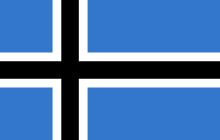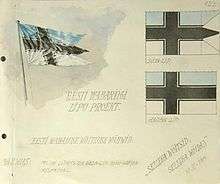Nordic identity in Estonia
Nordic identity in Estonia refers to opinions that Estonia belongs among the Nordic countries or that it should/will be considered as such in the future. The current mainstream view outside of Estonia does not usually include it among them. Categorizing Estonia as a Nordic country is common in Estonia.[1]



A push towards being defined as a Nordic country has existed in independent Estonia since the war of independence in 1918.[2][3] The Scandinavian connection from the Estonian Viking Age and later from being a part of the Danish and Swedish Empires left a lasting influence on the creation of the Estonian identity during the national awakening.[4]
Public attitudes
53.3% of ethnically Estonian youth consider belonging in the Nordic identity group as important or very important for them. 52.2% have the same attitude towards the "Baltic" identity group, according to a research study from 2013.[5]
The image that Estonian youths have of their identity is rather similar to that of the Finns as far as the identities of being a citizen of one’s own country, a Fenno-Ugric person, or a Nordic person are concerned, while our identity as a citizen of Europe is common ground between us and Latvians - being stronger here than it is among the young people of Finland and Sweden.[5]
...the importance of being a Nordic country has risen to an equal level with the Baltic identity among young people[5]
Sociologist Mikko Lagerspetz has observed that the attitudes towards the Nordic identity in the Estonian society can be grouped in three: 1) Estonia is already a Nordic country; 2) Estonia needs to become a Nordic country but is not there yet; 3) Estonia should walk its own unique path.[6]
Modern political narrative
An important element in Estonia's post-independence reorientation has been closer ties with the Nordic countries, especially Finland and Sweden. In December 1999, then Estonian foreign minister (and President of Estonia from 2006 until 2016) Toomas Hendrik Ilves delivered a speech entitled "Estonia as a Nordic Country" to the Swedish Institute for International Affairs.[7] In 2003, the foreign ministry also hosted an exhibit called "Estonia: Nordic with a Twist".[8] In 1999, the foreign minister Toomas Hendrik Ilves's speech in the Swedish Foreign Policy Institute of "Estonia as a new Nordic country".[9]
In 2015, the Estonian prime minister Taavi Rõivas defined the country's narrative as a "New Nordic Country", or "Uus Põhjamaa".[10]
A conference comprising the heads of the coalition government was held in September 2016, discussing Estonia's outlook as a Nordic country.[11]
Becoming a new Nordic country does not necessarily mean that we will emulate the Nordic countries – copying will never make us anything else than a poor copy of Sweden. We have got to get to where we need to with more courage to take risks, we need to show more initiative, to experiment more and to also make more mistakes, not just limit ourselves to learning from others and continuing to compare ourselves against others. - Taavi Rõivas, Prime Minister of Estonia[12]
Kersti Kaljulaid, president of Estonia since 2016, commented on views of then Estonian foreign minister Ilves, saying that she does not want to use "loaded words" like Nordic or Baltic but prefers to call like-minded countries of northern Europe the "Nordic Benelux".[13]
The Nordic narrative is also communicated by government agencies:
- Invest in Estonia – The national investment agency[14]
- Brand Estonia [15]
- RMK – The national forestry organization[16]
- Enterprise Estonia[17]
- The Foreign Ministry[8][18]
When state-owned Estonian flag carrier was renamed as Nordica in 2016, Erik Sakkov, then board member of the company, explained the airline's naming (according to some Estonian media outlets) with Estonia's continual self-identification among Nordic countries (Põhjamaad in Estonian) and with country's leaders wish to emphasize it in the name of the national carrier.[19][20] However, similar explanation by Sakkov which was published on Nordica homepage in English, claimed that motivation behind naming was Estonia's alignment with "Northern Europe" and country's leaders wish to reflect that.[21]
The Swedish ambassador to Estonia, Mr. Anders Ljunggren, has claimed in 2015 that Estonia would have been considered a Nordic country by the other Nordic countries, "had the history been different...The differences between Estonia and Sweden have become less year by year, owing to the fact that the two countries have gotten to know each other more each year".[22]
Criticism
The Tuglas foundation has claimed that the Nordic definition that Estonia is moving towards does not exist anymore, being a relic of past times.[23]
Per Högselius wrote an opinion piece about the topic in 2003, looking at the idea as fringe, but concluding that "in time the Estonians might be able to persuade us".[24]
Historic contacts with the Nordic Council
The Nordic Council had historically been a strong supporter of Estonian independence from the Soviet Union. The Nordic Council of Ministers' Office in Estonia was opened in spring 1991.[25]
See also
- Viking Age in Estonia
- Nordic countries
- Estonian kroon
- Baltoscandia
- Fennoscandia
- Intermarium
- Nordic-Baltic Eight
- Danish Estonia
- Swedish Estonia
References
- Kuldkepp, Mart. "Eesti põhjamaise identiteedi ajaloost" – via www.academia.edu. Cite journal requires
|journal=(help) - "Tiia Kõnnussaar: Eesti kui põhjamaa – elujõuline unistus | Eetikaveeb". Eetika.ee (in Estonian). 22 August 2016. Retrieved 16 December 2016.
- Estonia Gravitates Towards Sweden: Nordic Identity and Activist Regionalism in World War I | Mart Kuldkepp. Academia.edu. 1 January 1970. Retrieved 16 December 2016.
- Kuldkepp, Mart (2013). "The Scandinavian Connection in Early Estonian Nationalism". Journal of Baltic Studies. 44 (3): 313–338. doi:10.1080/01629778.2012.744911.
- "Identity in an Open World".
- "Põhjamaade saadikud soovivad Eestile rohkem diskussiooni valupunktide üle". 26 June 2017.
- Ilves, Toomas Hendrik (14 December 1999). "Estonia as a Nordic Country". Estonian Foreign Ministry. Archived from the original on 11 May 2011. Retrieved 19 September 2009.
- "Estonia – Nordic with a Twist". Archived from the original on 8 February 2008.
- "Välisminister Ilvese loeng Rootsi Välispoliitika Instituudis: "Eesti kui Põhjamaa" (inglise keeles) | Välisministeerium". Vm.ee (in Estonian). 14 December 1999. Retrieved 16 December 2016.
- "Taavi Rõivas: Eesti suur narratiiv on Uus Põhjamaa | Reformierakond". Reform.ee. 10 January 2015. Retrieved 16 December 2016.
- ""Estonia AND the Nordic countries – Estonia AS a Nordic country?" conference summary and videos". Norden.ee. Retrieved 16 December 2016.
- "Prime Minister Rõivas in his address to the nation on Independence Day: Estonia has many reasons to be a confident country".
- "Kersti Kaljulaid: Let's talk about the Nordic Benelux". Public Broadcasting of Latvia. 25 October 2016. Retrieved 16 December 2016.
- "Estonia - Nordic With A Twist". Invest in Estonia. 15 September 2015. Retrieved 16 December 2016.
- "Character — Brand Estonia".
- "RMK has the most visited forestry-related homepage | RMK". Rmk.ee. Retrieved 16 December 2016.
- "EAS - Ettevõtluse Arendamise Sihtasutus". Eas.ee. Retrieved 16 December 2016.
- "Estonia as a Nordic Country | Välisministeerium". Vm.ee (in Estonian). 14 December 1999. Retrieved 16 December 2016.
- Nordic Aviation Groupi uueks nimeks saab Nordica. Eesti Ekspress, 8 March 2016
- Eesti lennufirma saab uue nime, Äripäev, 8 March 2016
- Nordica - the story behind the new name of the airline
- "Mis on Põhjamaade edu saladus?". 12 June 2015.
- "Tuglas-seura | Kas Eesti on Põhjamaa?". Tuglas.fi. Retrieved 16 December 2016.
- "Estland längtar så in i Norden | Per Högselius | SvD". Svd.se. 20 November 2003. Retrieved 16 December 2016.
- "Intro". norden.ee.
